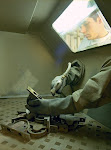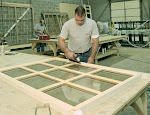I was in Birmingham, Alabama yesterday at a historic window mockup review and thought that addressing the importance of a mockup for preservation projects would be a good topic. Re-View is based in the “Show Me State” so we have always been believers in the value of a mockup.
The primary reason one would want to go through the extra cost and time of producing a sample historic window installation is to make sure the owner, architect, general contractor and window subcontractor are all on the same page. Misinterpretations of the scope of work can exist with any of these parties. These constituents might also learn something from performing a complete restoration of one window that might change the initial scope of work. The following are some actual examples of these types of lessons learned during the mockup process:
• We have had many projects where the scope of work called for restoring the existing frame and replicating the sash with an exact match to the existing in mahogany with insulated glass. The frame restoration called for removing loose existing paint, repairing the frame, and then finishing the frame in a matching color to the sash. When the mockup was produced, a new sash with a crisp factory finish and smooth surface was mounted into an old frame with a rough surface finish over the remaining lead paint. In some cases, the contrast of new to existing finishes are more than the owner and architect desire, calling for a change in frame restoration scope.
• On another project we had a requirement for an independent 6 pound water test to be performed on the mockup of an existing historic window. Unfortunately, there are few historic wood windows that were designed to perform at that level. In order to achieve that kind of performance the window needs to be redesigned, which often contradicts the historic intent of retaining the original look of the existing system. The independent test confirmed that a redesigned sill, stool, and weather stripping would be required. Be careful in applying modern ASTM testing standards to historic window designs.
• We had a project that called for laminated glass on a 12-lite over 12-lite double hung window. The specification called for including the mark found in the lower right corner of the glass designating the glass as safety glass. This mark is useful in a conventional one-lite window so the glass is easily confirmed to be laminated. To the project team’s dismay, we discovered how awful 24 glass marks look on a true-divided-lite window. The mockup was convincing evidence that we should eliminate the safety-glass marks on all window panes.
• A State Capitol project demanded historically correct ballistic windows in certain areas of the building that matched the other existing wood windows. The specification called for the window system to withstand a shot at 2,760 feet per second with a 7.62mm 150 grain, lead core full metal copper jacketed ball shot at a range of 15 feet. The construction team decided it was important to secure an independent test of a mockup to provide insurance to all involved that the custom design would in fact perform as required. This mockup helps shield the project team from the legal liability of product performance.
• On a courthouse project with four radius wings, we used two mockups to determine whether the glass and sash should follow the same radius as the building. We installed a flat glass sash next to a radius sash with bent glass in two windows. It was quite evident that the radius unit with bent glass was the preferred design based upon this visual test.
A mockup can also be very valuable for the window restoration subcontractor and the manufacturer of the historic replicas to learn how to perform the work outlined in the construction documents. In this business, every project presents different challenges and means and methods might have to be altered to achieve the desired effect. The construction documents might also be incomplete on certain elements that present themselves during the mockup process. We feel that learning these lessons before full-scale production work begins saves everyone a great deal of costs and headaches. The following are some actual examples of lessons learned from the mockup procedure:
• We had a steel window restoration project that called for a fluoropolymer finish paint combined with a linseed-based glazing putty. During the work on the mockup, we discovered failure of the paint adhesion on the putty. It is not uncommon to discover incompatibilities in paint finishes, putties, sealants, interlayers of laminated glass, and edge seals of insulated glass. Since these incompatibilities are not well documented by the manufacturers of these products, a mockup is a good way to determine whether the prescribed system will perform.
• Back in 2005 we restored 29 triple hung windows that had a sash opening of 8 feet wide by 24 feet tall. Each sash was 8 feet square with nine lites. The specification called for saving the existing glass and replacing broken glass with ¼” clear glass. As is typical of a project requiring the reuse of original glazing, a high percentage of the original glass was broken. The 91-year-old original glass had been permanently tinted by pollutants. The mockup we produced displayed a checkerboard effect where original polluted glass was matched up with new clear glazing.
• Many specifications call for restoring the existing locking hardware onto either a replicated sash with insulated glass or a restored sash converted for receiving insulated glass. We discovered during a mockup a long time ago that the original keeper that receives the sweep arm of the lock is too large to be reinstalled in the area that now has insulated glass. It is possible to purchase precisely replicated hardware to match the existing that has a modified keeper for just this type of application.
• There have been many instances where a manufacturer of historic replica windows failed to perform a mockup installation to test installation methods and fit within the wall cavity. We run across many different wall conditions with varying relationships from exterior masonry, interior framing, interior plaster, and existing trim.
Although a window mockup will add cost and delays to a project, it is certainly a worthwhile investment for all involved. Click on the following link to see pictures of these mockups on our Facebook page: https://www.facebook.com/media/set/?set=a.324097157646298.78668.118211914901491&type=1
Friday, March 23, 2012
Subscribe to:
Posts (Atom)




